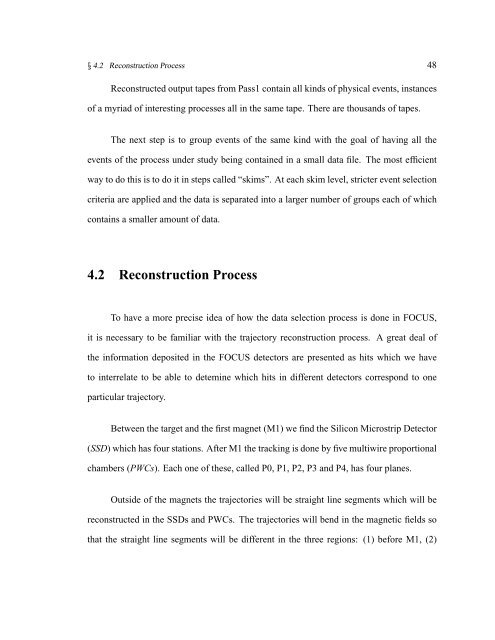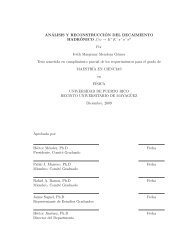A Search for Rare Decay D0 --> mu+mu - High Energy Physics UPRM
A Search for Rare Decay D0 --> mu+mu - High Energy Physics UPRM
A Search for Rare Decay D0 --> mu+mu - High Energy Physics UPRM
Create successful ePaper yourself
Turn your PDF publications into a flip-book with our unique Google optimized e-Paper software.
4.2 Reconstruction Process 48Reconstructed output tapes from Pass1 contain all kinds of physical events, instancesiof a myriad of interesting processes all in the same tape. There are thousands of tapes.The next step is to group events of the same kind with the goal of having all theevents of the process under study being contained in a small data file. The most efficientway to do this is to do it in steps called “skims”. At each skim level, stricter event selectioncriteria are applied and the data is separated into a larger number of groups each of whichcontains a smaller amount of data.4.2 Reconstruction ProcessTo have a more precise idea of how the data selection process is done in FOCUS,it is necessary to be familiar with the trajectory reconstruction process. A great deal ofthe in<strong>for</strong>mation deposited in the FOCUS detectors are presented as hits which we haveto interrelate to be able to detemine which hits in different detectors correspond to oneparticular trajectory.Between the target and the first magnet (M1) we find the Silicon Microstrip Detector(SSD) which has four stations. After M1 the tracking is done by five multiwire proportionalchambers (PWCs). Each one of these, called P0, P1, P2, P3 and P4, has four planes.Outside of the magnets the trajectories will be straight line segments which will bereconstructed in the SSDs and PWCs. The trajectories will bend in the magnetic fields sothat the straight line segments will be different in the three regions: (1) be<strong>for</strong>e M1, (2)






